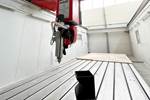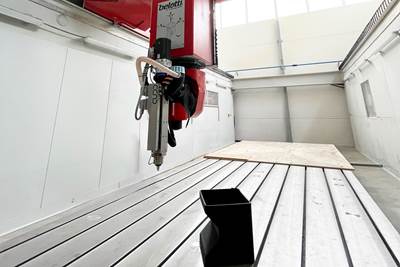HG Grimme CNC centers reduce ACE CFRP postprocessing setup
The switch to HG machining centers for the milling of automotive CFRP parts and structural components cuts setup time down from 40-45% to 2-3% and protects against dust generation.
Most carbon fiber parts consist of two separately manufactured outer and inner shells that are bonded together. Before this, the edges must be postprocessed. Source (All Images) | HG Grimme SysTech
(Wiedergeltingen, Germany) announces that by switching to its CNC machining centers, Tier 1 supplier (Salem-Neufrach, Germany) has significantly reduced setup times for milling operations on carbon fiber-reinforced polymer (CFRP) components. Machine downtime now amounts to a maximum of only 3%, down from up to 45% previously.
ACE primarily manufactures CFRP parts for premium automotive manufacturers. CFRP Class A visible parts and structural components from ACE require milling of contours and trims prior to painting. For this purpose, the company uses three P-S-F (20-25)/S five-axis CNC portal milling machines from HG Grimme SysTech.
ACE acquired the identical machining centers, each with two tables and a shuttle as well as a Siemens 840d sl control system, between 2016 and 2024. Consistent operation and machine tables with the same hole pattern and a fixed zero point also contribute to short setup times. Furthermore, ACE can postprocess the CFRP parts on all machines from HG Grimme SysTech interchangeably and without any quality limitations.
The milling systems are suitable for workpieces with external dimensions of up to 2,000 × 2,500 × 650 millimeters, which can be machined with optimal dynamics thanks to rapid traverse speeds of 80 meters/minute in X/U/Y axes and 30 meters/minute in the Z-axis.
Around two-thirds of the components and assemblies made from CFRP are visible parts, mainly for car bodies, in particular wings and bonnets.
Double tables and shuttles result in a machine length of just under 11 meters and a width of slightly less than 6 meters. This simultaneously provides sufficient space for good accessibility to the machine table and milling head from all sides.
The components to be machined are up to 2,000 × 2,500 millimeters in size, with thicknesses between 1 and 3 millimeters, and batch sizes usually vary between 500 and 10,000 pieces.
Around two-thirds of the products are visible parts, predominantly for car bodies, particularly fenders and hoods. The remaining parts are structural components such as monocoques for the drivetrain, battery trays for electric vehicles, and paneling for B-pillars and center struts.
Given the significant dust generation during CFRP milling, CNC machining centers from HG Grimme SysTech are completely encased, and an extraction system removes many airborne particles directly within the enclosure. Furthermore, the components are manually cleaned again with high pressure after machining.
The shuttle system with two tables reduces downtime of the milling centers to 2-3% of the machine running time — compared to 40-45% for a system with only one table.
“HG Grimme understands something about processing composite materials, and the communication is at eye level,” says Peter Klaus Gröschl, production manager and one of the managing directors of ACE. “The company is down-to-earth. We enjoy working together.”
ACE manufactures 90% of its CFRP components and assemblies using closed resin transfer molding (RTM). In this process, textile preforms are cut and prepared into layups, which are then placed in presses, injected with resin, and cured into shells. The edges of the two, or less frequently three, shells still need to be milled before they are subsequently bonded together to form the carbon fiber part.
After contour and trim milling, the bonded and painted components are inspected before ACE delivers them to its customers' assembly lines. This includes well-known brands such as Lamborghini, Porsche, Aston Martin, Bugatti, BMW, Mercedes, AMG, Audi, and Volkswagen. The most important customers from the aerospace industry are Airbus and Boeing.
Related Content
Composites end markets: New space (2025)
Composite materials — with their unmatched strength-to-weight ratio, durability in extreme environments and design versatility — are at the heart of innovations in satellites, propulsion systems and lunar exploration vehicles, propelling the space economy toward a $1.8 trillion future.
Read MorePlant tour: Aernnova Composites, Toledo and Illescas, Spain
RTM and ATL/AFP high-rate production sites feature this composites and engineering leader’s continued push for excellence and innovation for future airframes.
Read MorePlant tour: Airbus, Illescas, Spain
Airbus’ Illescas facility, featuring highly automated composites processes for the A350 lower wing cover and one-piece Section 19 fuselage barrels, works toward production ramp-ups and next-generation aircraft.
Read MoreIndustrializing additive manufacturing in the defense/aerospace sector
GA-ASI demonstrates a path forward for the use of additive technologies for composite tooling, flight-qualified parts.
Read MoreRead Next
Belotti retrofits Vega CNC center in BEAD hybrid machine for D-Composites
Combined LSAM and five-axis CNC milling capabilities will optimize D-Composites’ production services, flexibility and cut time and cost for composite tooling manufacture.
Read MoreRuckus Composites, Aerospace grows in-house composites machining, measurement and inspection
Recent in-house technology investments set Ruckus up to meet advanced composite inspection and precision machining demand.
Read MoreNorco invests in CNC, kit cutting capability expansion
Transition from internal to external demand over the last few years has evolved Norco’s machining and composite kit cutting equipment, and now includes material outsourcing and digital engineering services.
Read More












